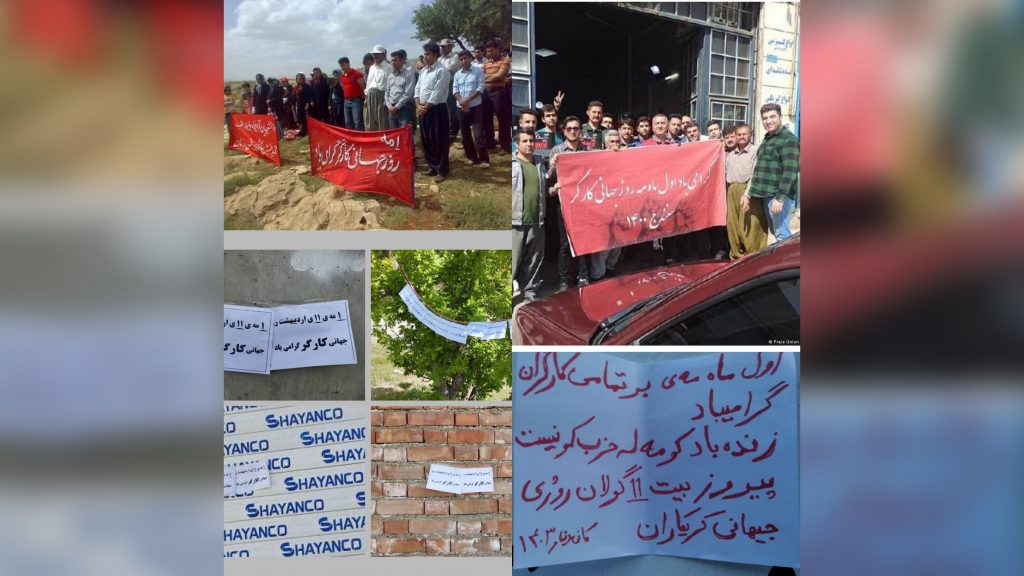
Throughout more than four decades of struggle and resistance in Kurdistan, valuable pioneering traditions have been established in this society. One of these traditions is the holding of ceremonies for International Workers’ Day. This tradition has persisted through the toughest days of the Islamic Republic’s rule and even in times when the Iran-Iraq War had affected all aspects of life in this region and the shadow of the enemy’s spear had loomed. Sacrifices have been made, prisons and torture endured, exile endured, unemployment and expulsion tolerated, but the flag of the first of May has not fallen to the ground in Kurdistan. The anti-worker regime of the Islamic Republic has advanced in this regard to the point of executing militant workers such as “Jamal Cheraghveisi” and “Abdullah Beyoseh,” but it has not succeeded. This steadfastness and resilience have forced the regime to officially recognize the closure of this day. Although to prevent the holding of independent workers’ ceremonies, it launches state ceremonies, in Kurdistan, such state ceremonies are boycotted by the workers en masse as a tradition.
On May 1, 1979, under conditions where the Islamic regime had not yet established its dominance over Kurdistan, International Workers’ Day was celebrated with grandeur in all cities of Kurdistan. On this day, a magnificent procession was held in the city of Mahabad with the participation of thousands, which was a demonstration of the power of workers and hardworking people in this city.
In 1983, in a completely military and wartime atmosphere, in the midst of small-scale but militant and memorable suppression in the city of Mahabad, International Workers’ Day was celebrated. This initial movement in those years of pressure, suppression, and oppression played a very serious role in keeping alive this workers’ tradition, which is unforgettable.
Another example of the glorious ceremonies of International Workers’ Day was on May 1, 1987, in Sanandaj. On this day, although the Islamic Republic had long prepared itself to confront workers’ gatherings and had come to the field with mobilized suppressive forces and launched propaganda campaigns, controlling the streets, besieging workers’ neighborhoods, and conducting extensive body searches, it had already announced that no independent ceremonies should be held. However, from the day before May 1, workers and toilers of Sanandaj began their work and spread calls for holding ceremonies on this day in workers’ neighborhoods. Eventually, numerous ceremonies were held in “Azadi Passage, Clothing Factory, Shahou Factory,” among workers and worker families.
The first resolution of May 1, 1987, by the workers of Sanandaj, in addition to demanding the recognition of Workers’ Day and the closure of work on this day, called for the right to organize and strike, 40 hours of work per week, wages commensurate with inflation, prohibition of child labor under 18 years old, special attention to women workers, and several other demands.
Another notable example of the magnificent and militant ceremonies that have been recorded in the history of workers’ struggles in Iran was the celebration of May 1, 1989, in Sanandaj. On this day, a large gathering of workers was held in the Takhti Sports Hall in Sanandaj. The ceremony began with the singing of the Internationale and continued with an enthusiastic speech by the Communist worker martyr “Jamal Charaghveisi.” During his comprehensive speech, he emphasized the necessity of unity and solidarity, and the importance of establishing workers’ organizations and strengthening the ranks of the struggle against the capitalist system and the unequal conditions in society. The splendid demonstrations of the May 1 ceremonies in 1989 in Sanandaj will never be forgotten. The flame of International Workers’ Day ceremonies in Sanandaj never extinguished thereafter, and over time, each year brought forth new traditions.
Workers and labor activists in the city of Saqqez have also always been among the pioneers of the workers’ movement in organizing International Workers’ Day ceremonies. In the years 1990, 1991, and 1992, we witnessed courageous examples of holding workers’ ceremonies. The most enthusiastic example was held in 2005. Over the past few decades, labor activists in this city have faced imprisonment, torture, and threats from the regime, but they have never allowed the flag of this historic day, as a symbol of working-class solidarity, to fall to the ground.
This tradition, upheld by pioneering workers and their families every year in most cities of Kurdistan, including Kermanshah, Oshnavieh, Boukan, Marivan, Baneh, Kamiaran, Divandareh, Rabat, and Sardasht, in various forms ranging from street marches to gatherings within the city and sometimes assemblies outside the city, has been preserved. Labor activists on this occasion have crossed the walls of suppression and regime oppression, and every year, with enthusiasm and fervor, they have welcomed their International Day.
These traditions and the presence of pioneering activists and workers strengthen the hope that this year as well, despite any obstacles, the masses of workers will not remain unaware of commemorating this historic day, and they will do everything in their power to hold their International Day ceremonies.

